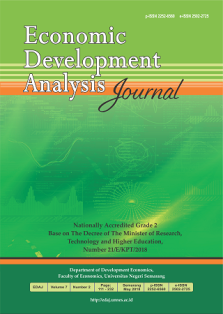PENGARUH PERTUMBUHAN EKONOMI DAN INFLASI TERHADAP UPAH MINIMUM REGIONAL DI KABUPATEN/KOTA PROVINSI JAWA TENGAH TAHUN 2008-2011
Abstract
Upah minimum regional merupakan salah satu komponen penting dalam kehidupan masyarakat yang digunakan sebagai pemenuhan kebutuhan hidup bagi tenaga kerja, guna meningkatkan taraf hidup. Peningkatan taraf hidup masyarakat dapat dilihat dari pertumbuhan ekonomi, yakni pertumbuhan ekonomi yang baik terdapat jumlah angkatan kerja berdasarkan pendidikan tertinggi yang ditamatkan cukup banyak. Penetapan upah yang tinggi menyebabkan kenaikan harga-harga yang ada di pasaran, sehingga mengakibatkan terjadinya inflasi.
Penelitian ini menganalisis bagaimana pengaruh pertumbuhan ekonomi, dan inflasi terhadap upah minimum regional. Metode analisis yang digunakan dalam penelitian ini adalah menggunakan analisis regresi data panel model random effect (REM) dengan metode Generalized Least Square (GLS). Jenis data yang digunakan berupa gabungan dari data time series (periode 2008-2011) dan cross section (35 kabupaten/kota) yang bersumber dari Badan Pusat Statistik Provinsi Jawa Tengah.
Hasil dari penelitian ini adalah koefisien positif dari pertumbuhan ekonomi adalah 20,561 yang berarti jika pertumbuhan ekonomi naik 1% maka UMR naik Rp 20.561. Koefisien negatif dari inflasi sebesar 13,564 yang berarti jika inflasi naik sebesar 1% maka UMR juga naik sebesar Rp 13.564.
Simpulan dari penelitian ini menunjukkan bahwa pertumbuhan ekonomi dan inflasi secara parsial berpengaruh terhadap upah minimum regional. Saran yang berkaitan dengan penelitian ini adalah diperlukan upaya dari pemerintah untuk meningkatkan pendapatan masyarakat, dan menstabilkan harga-harga di pasar sehingga dapat meningkatkan penetapan upah minimum regional sesuai kebutuhan hidup masyarakat.
Minimum wage is one important component in the lives of people who are used as subsistence for workers, to
improve the standard of living. Improving standards of living can be seen from economic growth, that there are
good economic growth based labor education highest education attained quite a lot. High wages lead to rising
prices on the market, which causes inflation.
This analyzed the influence economis growth, and inflation to minimum wages. The method of analysis used
in this research is to use panel data regression analysis of random effects model (REM) with the method of
Generalized Least Square (GLS). Data used in the form of a combination of time series data (2008-2011) and
cross section (35 regencies / cities) are sourced from the Central Statistics Agency of Province Central Java.
The results from this research are the positive coefficient of economic growth is 20,561, which means if the
Economic growth rise 1% then minimum wages rise to Rp 20.561. Negative coefficient of inflation of 13,564,
which means that if inflation rise 1% then the minimum wages declines by Rp 13.564.
The conclusions of this study indicate that economic growth and inflation in partial effect on minimum wages. Suggestions related to this research effort is required from the government to increase incomes, particular by
increasing specialization of labor to do the training, and stabilize prices in the market so as to increase the
minimum wage according to the needs of life.
References
Ajija, Shochrul R,dkk. 2011. Cara Cerdas Menguasai Eviews. Jakarta: Salemba Empat
Arikunto, S. 2006. Prosedur Penelitian Suatu Pendekatan Praktik. Jakarta: Rineka Cipta
Arsyad, Lincolin. 2004. Ekonomi Pembangunan. Yogyakarta: STIE YKPN Yogyakarta
Case, K.L dan Fair, R.C. 2005. Prinsip-Prinsip Ekonomi Mikro. Edisi ketujuh. Jakarta: Indeks Kelompok Gramedia
Gie, Kwik Kian. 1999. Ekonomi Indonesia dalam Krisis dan Transisi Politik. Jakarta: PT. Gramedia Pustaka Utama
Gujarati, D.N. dan D.C. Porter. 2010. Dasar-Dasar Ekonometrika, Edisi 5. Jakarta: Salemba Empat
____________________________. 2012. Dasar-Dasar Ekonometrika, Edisi 5.
Jakarta: Salemba Empat
Prasetyo, P.Eko. 2009. Fundamental Makro Ekonomi. Yogyakarta: Beta Offset
Sarwoko. 2005. Dasar-Dasar Ekonometrika. Yogyakarta: Andi Ofset
Soleh, Maimun. 2005. Dampak Kenaikan Upah Minimum Propinsi Terhadap Kesempatan Kerja (Studi Kasus Propinsi Jawa Tengah). Jurnal Ekonomi dan Pendidikan, Volume 2 Nomor 2, Desember 2005
Sugiyono. 2011. Metode Penelitian Kuantitatif dan Kualitatif dan R&D. Bandung: Alfabeta
Sukirno, Sadono. 2002. Pengantar Teori Ekonomi Mikro. Edisi ketiga. Jakarta: PT. Raja Grafindo Persada
. 2008. Mikro Ekonomi Teori Pengantar. Jakarta: PT. Raja Grafindo Persada
. 2008. Pengantar Teori Makroekonomi. Jakarta : Raja Grafindo Persada
Sulistiawati, Rini. 2012. Pengaruh Upah Minimum terhadap Penyerapan Tenaga Kerja dan Kesejahteraan Masyarakat di Provinsi di Indonesia. Jurnal EKSOS Volume 8, Nomor 3, Oktober 2012: 195-211
Sumarsono, Sony. 2003. Ekonomi Manajemen Sumber Daya Manusia dan Ketenagakerjaan. Yogyakarta: Graha Ilmu


